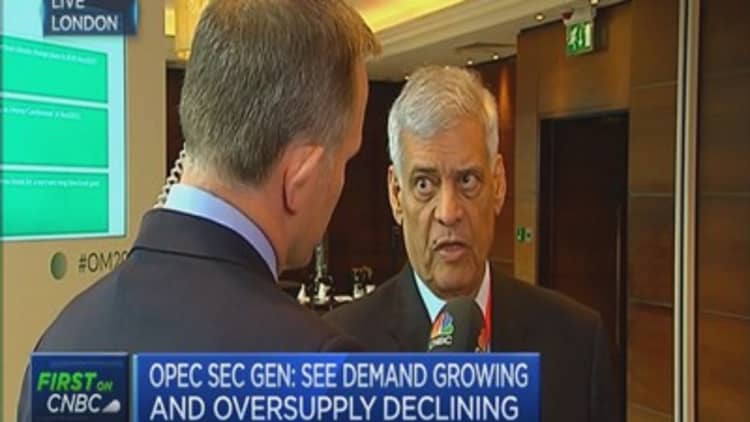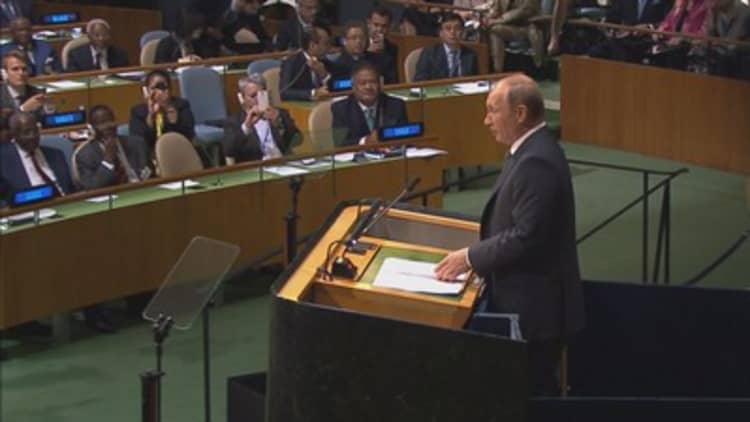






Oil industry leaders have dismissed talk of the price of crude hitting the $20 lows predicted by analysts, who warned that believing that "oil prices will be with us forever may not be the right way of thinking."
Goldman Sachs stirred energy investors last month when its head of commodity research warned of rising risks of oil prices falling as low as $20 per barrel, in a message that was reiterated on Tuesday.
"The risk of $20 is driven by what we call a breach in storage capacity, meaning that you have supply above demand, you fill every storage tank on planet earth and then you have nowhere to put it," Jeff Currie, head of commodity research at Goldman told CNBC from the annual Oil & Money conference in London.
"(Then) supply has to come down in line with demand. The only way you get that correction is prices crash down to cash costs, which for a U.S. producer, is somewhere around $20 a barrel."
However, Fatih Birol, the executive director of the International Energy Agency (IEA), told CNBC on Tuesday that low prices would prompt U.S. producers to cut output, creating upward price pressure.
"When we look at the next few quarters, we expect U.S. oil production to decline because of low oil prices and in Iraq, production growth will be much slower than in the past. And the demand is creeping up," Birol told CNBC on Tuesday from the Oil & Money conference.
"So therefore, to think that oil prices will be with us forever may not be the right way of thinking."
Energy Futures
The U.S.-led revolution in the extraction of shale gas via hydraulic fracturing or "fracking" has pushed more oil into the market. At the same time, the OPEC group of oil-producing countries have stood firm in the face of international pressure to cut prices. Meanwhile, Iraq has increased production, while demand growth for energy has slowed, largely due to the deacceleration in the Chinese economy.
This has helped catalyze an historic collapse in the price of crude oil, with both Brent and WTI trading below $50 per barrel, down from around $110 per barrel until June 2014.
Whether or not U.S. shale players will cut production in response to ongoing low prices is a moot point however. They could instead respond by increasing production in order to satisfy creditors eager for results. Plus, against some odds, shale producers have managed to lower productions costs, although these remain high in comparison to conventional oil production.
Despite its warning, Goldman Sachs said there was a less than 50 percent chance of oil falling to $20 per barrel. Instead, its base case scenario for 2016 was $45 per barrel—a level that Birol said was still too low for U.S. shale producers to maintain current production.
"It is proven it is a very resilient type of production, but this level of prices, $45, $50 is not good enough to induce reinvestments and for production to continue to grow. Therefore, we expect as of next year, production growth will decline in the United States," Birol told CNBC.
OPEC will 'cooperate with anybody…even US'
The secretary general of OPEC, Abadall El-Badri, also forecast that oil production from countries outside his group would fall next year.
"All I can tell you is that we see improvement," he told CNBC from the Oil & Money conference in on Tuesday.
"We see that non-OPEC supply is declining and in 2016, we see there is an increase in demand … so in a nutshell, there is a balance in the market in 2016. How much this will reflect on the price I really cannot tell," he later added.
El-Badri added that he was open to discussing production concerns with the U.S., or any other non-OPEC country.
"In general, OPEC, as far as I can say as secretary general, we have no problem with cooperating with anybody. Even with the United States producers. If they want to talk to us, we are willing talk to them, because now the situation is really affecting almost everybody. United States, OPEC, non-OPEC, everybody," he said.
S&P takes ratings action on 14 energy firms
Standard & Poor's (S&P) appeared more bullish on oil prices than Goldman, forecasting on Tuesday that Brent oil would average $55 per barrel in 2016, up from an average of $50 for the remainder of this year.
Nonetheless, the weak price environment saw the ratings agency take ratings action on 14 oil and gas exploration and production companies on Tuesday.
S&P cut the ratings on EnQuest and Tullow Oil to "B" and "B+" respectively and placed BP, Eni, Nostrum, Repsol, Statoil and the State Oil Company of Azerbaijan Republic on "CreditWatch Negative."
"Actual and forecast financial results in 2015 are typically weak or very weak," said S&P on Tuesday.
"Correspondingly, credit metrics are likely to be at or below our guidelines for ratings and we see very substantial negative DCF (discounted cash flow) for European oil and gas majors in particular."
—By CNBC's Katy Barnato. Follow her on Twitter @KatyBarnato.





